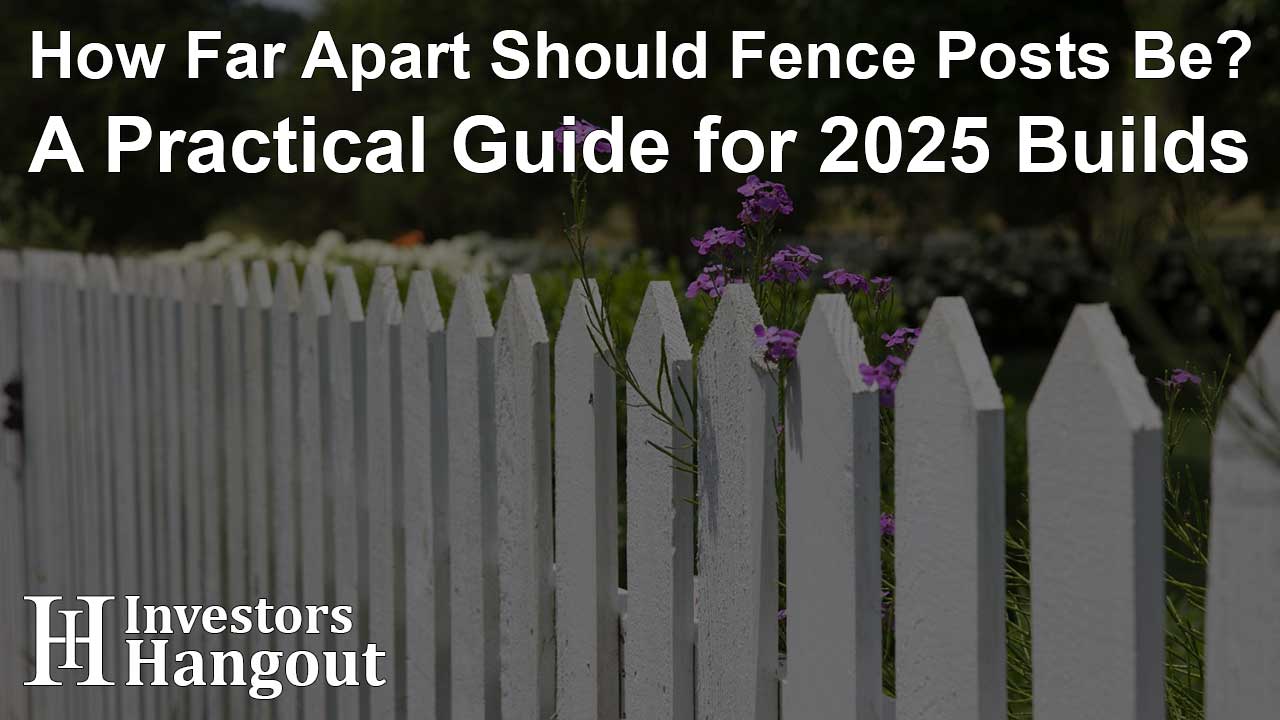How Far Apart Should Fence Posts Be? A Practical Guide for 2025 Builds

When building a fence, one of the most important—and often overlooked—details is post spacing. Place your posts too far apart, and panels may sag or fail. Place them too close, and you could waste materials and inflate costs unnecessarily. Getting this right ensures your fence not only looks good but also stands the test of time.
This guide covers standard fence post spacing for different materials, factors that affect how far apart posts should be, and pro tips for planning a durable, long-lasting installation.
Why Fence Post Spacing Is So Important
Structural Support and Long-Term Strength
Fence posts are the foundation of your fence. They carry the weight of panels, resist lateral wind forces, and keep everything aligned. Inadequate spacing can lead to instability, bowing, or premature failure—especially in areas with high winds or heavy rains.
Visual Consistency
Even spacing isn't just functional—it also affects how the fence looks from the street. Irregular or uneven spacing is noticeable, particularly with decorative or privacy fences. Careful measurement and layout ensure the final product looks as polished as it is practical.
Standard Fence Post Spacing by Material
Wood Fence Posts
For wood fences, post spacing typically falls between 6 and 8 feet. If you're using pre-made panels, follow the panel length—most are 6 or 8 feet wide. For privacy fences or taller installations, reduce spacing to 6 feet for better wind resistance and rigidity.
Vinyl Fence Posts
Vinyl fencing usually relies on fixed panel sizes, also ranging from 6 to 8 feet. However, vinyl is lighter than wood, which helps maintain stability over longer spans. In high-wind zones, spacing should still lean toward the shorter end of that range.
Chain Link Fence Posts
Chain link posts are typically spaced 7 to 10 feet apart, with line posts supporting mesh between terminal (corner, end, or gate) posts. Closer spacing is preferred for taller fences or areas prone to sagging.
Metal or Aluminum Fence Posts
Like wood, metal or aluminum fences generally follow a 6 to 8-foot spacing guideline. If using decorative panels with vertical pickets, ensure your spacing supports the weight without bending.
For a more detailed breakdown of spacing by fence type, Cool Cat Fence provides a helpful homeowner guide that covers spacing ranges and practical installation tips.
Factors That Influence Post Spacing
Fence Height and Design
The taller the fence, the more wind resistance it will face—especially privacy fences. Increased height typically requires posts to be placed closer together to maintain strength and stability. Decorative or semi-private styles may allow for wider spacing.
Local Climate and Wind Load
If you're in an area with strong winds or storms, reduce post spacing by 1–2 feet from the standard recommendation. Closer spacing increases rigidity and lowers the chance of panels bowing or detaching during severe weather.
Soil Conditions and Ground Slope
Soft or sandy soil requires deeper posts and sometimes closer spacing to anchor the fence securely. On sloped terrain, spacing may need to be adjusted to maintain consistent height and ground clearance across all sections.
Post Materials and Installation Considerations
Wood vs. Steel vs. Concrete Posts
-
Wood: Affordable and easy to install, but susceptible to rot if not properly treated or installed with concrete footings.
-
Steel: Ideal for chain link and security fencing. Stronger and longer-lasting than wood, especially in commercial applications.
-
Concrete: Not a post material itself, but essential for anchoring. Deeper concrete footings improve stability, especially on taller fences.
For high-security or commercial-grade fencing where post spacing must meet stricter durability standards, https://inlinesecurityfence.com/ offers professional installation and reinforced solutions built to last.
Recommended Depth and Diameter for Post Holes
As a general rule, dig post holes at least 1/3 the height of the fence. For an 8-foot-tall fence, that’s 2.5–3 feet deep. Use a post hole diameter of 3 times the post width, especially for wood. For example, a 4x4 post would need a 12-inch hole.
How to Plan and Mark Fence Post Locations
Start with Accurate Measurements
Measure the full length of your fence run. Divide it by the ideal spacing (usually 6 or 8 feet) to calculate how many posts you’ll need. Adjust as necessary so your last panel doesn’t end up too short or unsupported.
Use Stakes and String Lines
After calculating placement, use stakes and string lines to mark a straight fence path. Spray paint or flags can mark the center of each post hole. Double-check your layout before digging to avoid misalignments.
Common Mistakes to Avoid
Overstretching the Span
Trying to save time or money by placing posts too far apart often leads to sagging panels and poor wind resistance. Follow manufacturer guidelines for spacing—especially for pre-built panels.
Ignoring Terrain Adjustments
Level ground is rare. On slopes, adjust post heights and spacing to accommodate stair-stepping or racking the fence. This ensures consistent aesthetics and function.
Inconsistent Depth or Anchoring
If some posts are set deeper than others—or anchored in different materials—the fence may lean or shift unevenly over time. Consistency is key to long-term performance.
Conclusion: Strong Fences Start with Smart Spacing
Proper post spacing is critical to the performance, longevity, and appearance of any fence. Whether you're building with wood, vinyl, metal, or chain link, the distance between posts directly impacts strength and reliability—especially in variable weather conditions.
By following spacing best practices and adjusting for material, terrain, and environment, you’ll create a fence that holds up for years. For guidance on homeowner-friendly layouts, Cool Cat Fence is a valuable resource. And when you're working on a secure, professionally installed perimeter, trust the proven quality from Inline Security Fence.
About The Author
Contact Owen Jenkins privately here. Or send an email with ATTN: Owen Jenkins as the subject to contact@investorshangout.com.
About Investors Hangout
Investors Hangout is a leading online stock forum for financial discussion and learning, offering a wide range of free tools and resources. It draws in traders of all levels, who exchange market knowledge, investigate trading tactics, and keep an eye on industry developments in real time. Featuring financial articles, stock message boards, quotes, charts, company profiles, and live news updates. Through cooperative learning and a wealth of informational resources, it helps users from novices creating their first portfolios to experts honing their techniques. Join Investors Hangout today: https://investorshangout.com/
